I want to know how to ensure the sort indicator in the horizontal header of a QTableView is updated when a programmatic sort is performed on the model.
Here's the problem:
QStandardItemModel model(3,1);
QTableView view;
view.setModel( &model );
// Populate the model ensuring it is not in a sorted order
for( int row = 0; row < model.rowCount(); ++row )
{
model.setItem( row , 0 ,
new QStandardItem(QString::number((row+1)%model.rowCount())));
}
view.setSortingEnabled( true );
// At this point everything is consistent since enabling the sorting
// triggers a sort that matches the indicator in the horizontalHeader (see A)
model.sort( 0 , Qt::AscendingOrder );
// However at this point the sort order has been reversed but the
// header's sort indicator remains unchanged (see B)
A:  B:
B:
As you can see the sort indicator remains the same and therefore is inconsistent with the actual sort order.
In my application I have two views that interact with the same model and sorting can be triggered from either of them. I don't see anything in QAbstractItemModel that signals when a sort has been performed. It seems like QHeaderView/TableView assume that they are the only thing that can trigger a sort.
Does Qt provide facilities for coping with this that I'm missing? If not, what's the best way of keeping the sort indicator up-to-date without breaking the encapsulation of the multiple views on the model too much?